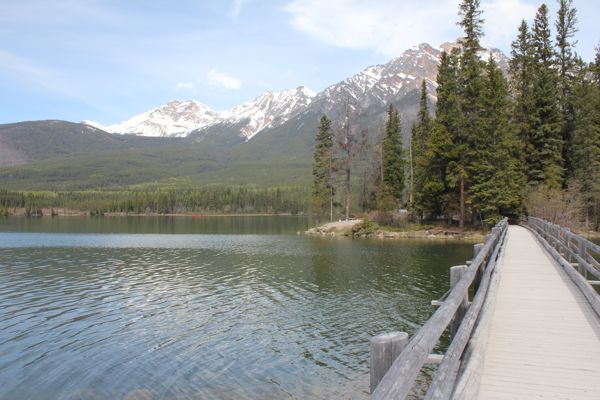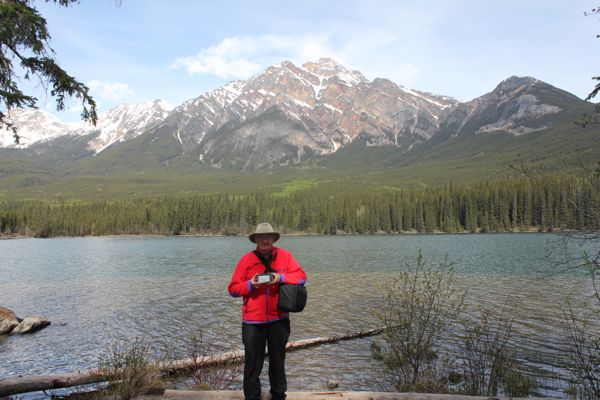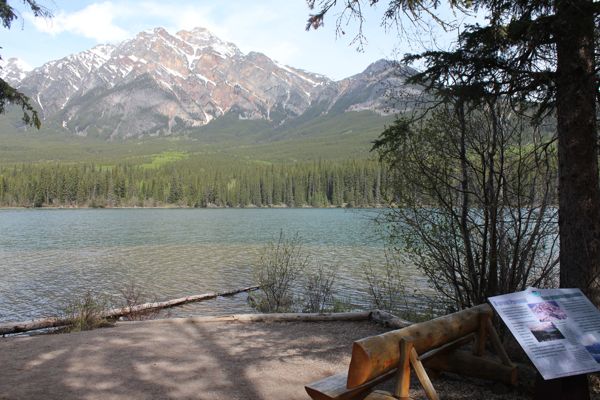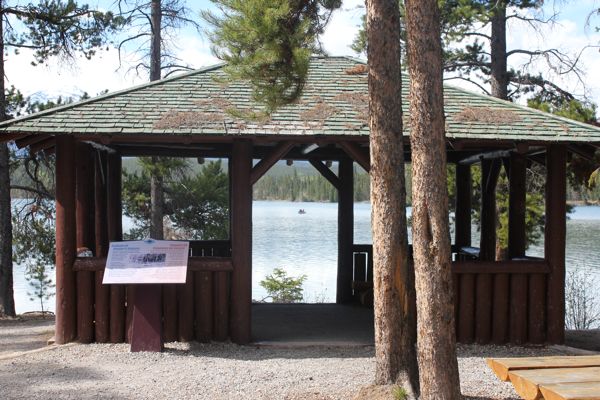May 26/2010 |
Geocache Activity 662 |
FIND 604 |
IDENTIFICATION
Difficulty 1; Terrain 2; size not chosen; Creator: Sleepy_hollow Date First Hidden: 6/1/2009 Date Last Found: 5/23/2010 Description The Pyramid Lake Earthcache is located about 7 km north of the Jasper townsite in Jasper National Park, Alberta, Canada. It lies at the foot of Pyramid Mountain (2768 m), a natural landmark that overlooks the town of Jasper. Pyramid Lake has a total area of 1.2 km² (0.5 sq mi) and discharges into the Athabasca River through the 2 km long Pyramid Creek.
The coordinates for the Pyramid Lake Earthcache takes the cacher to Pyramid Island which can be accessed via a boardwalk jointly built by Parks Canada and the Friends of Jasper National Park.
Mount Edith Cavell can be seen to the southeast when crossing the boardwalk. Mount Edith Cavell is one potential source of the Gog quartzite erratics which form the Foothills Erratic Train stretching from Jasper National Park to Montana in the USA. The Ramparts in the Tonquin Valley and the Endless Chain Ridge on the Icefields Parkway are other possible sources. Several well known erratics from this area can be found in Calgary area - The Big Rock near Okotoks and Crater Rock in the northwest Calgary community of Panorama Hills. Nearby Mount Edith Cavell is one of the most prominent landmarks in the Athabasca Valley. Voyageurs looked for the massive face of “La Montagne de la Grande Traverse” to guide them to the Athabasca Pass and the fur trade route to the west. Today at Mount Edith Cavell, visitors have unparalleled opportunities to discover three types of glaciers, a variety of moraine, primary plant colonization in the wake of the retreating Angel Glacier, and the sheer north face of Mount Edith Cavell. Mount Edith Cavell and the Foothills Erratics Train Erratics are large boulders that have been transported and deposited by glaciers. In southern Alberta, along the eastern side of the Rocky Mountains, thousands of erratics form a train over 600 kilometers long. When geologists examined the rocks, they discovered that they were all made of the same kind of rock, and they traced the source of that rock to an area around Mount Edith Cavell in Jasper Park. Thousands of years ago, these large stones fell onto the surface of the Cordilleran ice sheet during a landslide, and then were slowly carried by the ice sheet outward onto the Plains. When the ice melted, the long train of boulders was left behind. These rocks contain clues that have helped scientists to understand the movements of the ice sheets that covered Canada during the Late Wisconsinan glacial stage. The pathway of the erratics takes a sharp right-angle turn out on the Plains, changing from an easterly to a southerly direction. Scientists believe that the western Cordilleran ice sheet which was carrying the erratics met the eastern Laurentide ice sheet, and got deflected southward. Pyramid Lake and the peaks in the immediate vicinity were carved long ago by the glaciers in the area. In order to log a find for this Earthcache please e-mail the cache owner (don't post) answers to the following questions: 1. Pyramid Mountain was carved from the hardest rock layer in Jasper National Park. What was the name of the rock layer? What was the composition of the rock layer? What well known mineral can also be found in the rock and what is it's commonly known name? 2. What caused the pink and orange hues which can be seen in Pyramid Mountain? 3. How deep is Pyramid Lake? Why isn't it as deep as some of the other lakes in the area? 4. Post a picture of yourself at the Earthcache site with GPS in hand and the Pyramid Mountain back drop. Enjoy!
Hint
Comments
PLANNING
Early this morning I downloaded the cache coordinates for two Earth caches, as well as 3 regular caches that I had failed to find when we were here last year. We decided to try for the two Earth Caches in the Jasper area in the morning. This was our first one.
OUTCOME
We drove up to Pyramid Lake and quickly found the information plaque that gave the answers to the questions.
Here is my posting to the geocaching.com website:
A special Earth Cache for me, as I remember having picnics on this island when I was a boy over 50 years ago. Email to follow. Here are a few photos:
boardwalk to island
nosweat6060 at Earth cache site
Earth cache site
picnic shelter on island (now a national historic site)I am 1/1 for today. When we returned to the Whistlers Campground I was able to access the Internet by tethering my laptop to my iPhone and emailed the originator with the answers to the questions.





